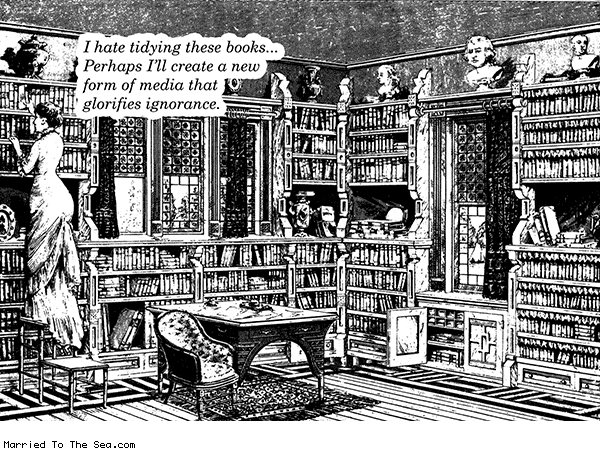Design, Destruction, and Reading
Here’s what was important this week…
As the web and technology become ever more ingrained in our day to day lives, the role of designers becomes more apparent. Designers have been around since things began to be created, and according to one man, they’ve destroyed the world.
It’s a bold statement. But designers (architects, if you’re a designer of buildings and structures) have designed prisons, and even the [solitary housing units (SHUs)](broken link removed) that unconstitutionally detain inmates.
Mike Monteiro wants to change that. In his 45 minute long talk (it’s worth it, though I admit my attention was wavering at the 40 minute mark), he passionately declares that it is the responsibility of all designers to be gatekeepers for bad, and outright harmful, design. And he has a point. If something isn’t designed, it can’t be built (or at least, not very well). He calls on designers to recognize the power that they have, even if they don’t realize it.
And Monteiro is not alone in advocating for this. Architects design prisons, but Raphael Sperry is an architect who wants to “amend the AIA’s [American Institute of Architect’s] Code of Ethics and Professional Conduct to “prohibit the design of spaces intended for long-term solitary isolation and execution.””
Still others have taken the proactive route, [aiming to combat suicide attempts with architecture](broken link removed).
Dan Lockton took it to another level and wrote his master’s thesis about Architectures of Control. Architectures of control is the park bench that has an arm in the middle of it so the homeless can’t sleep on it, or the railings with ridges on them so that skateboarders can’t grind on them. Typically seen as a negative creation, there is also the concept of Design with Intent (which Lockton has also (seemingly) coined), which is “strategic design that’s intended to influence or result in certain user behaviour.”
Pretty straightforward. Most things are created with intent. Monteiro demands that you be aware of and have some say about whether the intent is good, and, even if the intent is good, whether there are unintended consequences which could be harmful. Designing park benches with railings in the middle are great for people that like sitting in the middles of benches but also like armrests. And harmful to larger groups of people, and tired homeless (or drunk) people.
Design can have further unintended consequences, removed from the nature of intent. Globalization has meant that design from America is being exported worldwide, so cultural differences that may be important in some areas (e.g. the German value of time) can get [erased through an American-exported UI (user interface)](broken link removed) that perhaps de-emphasizes the location of the clock.
Design can also be damaging when it is designed with too narrow a purpose in mind, or by simply ignoring a sector of the population. As I’ve noted before, [designing for women is important](broken link removed). And as David A. Banks points out in this Cyborgology essay, the Design Sir simply doesn’t understand how (or why) to do that. What results is a world blind to the needs and wants of women, and to hearken back to Monteiro again, one rife with misogyny.
Misogyny in technology fields is so common that I won’t even reference that with a link. Thankfully, there are many people doing something about it. Two of those people, Amelia Greenhall and Shanley Kane, founded a brand new publication called Model View Culture to bring more diversity to the tech industry, and the coverage it receives. (So far, I’ve really enjoyed this piece: Tech Workers, Political Speech and Economic Threat.) As the founders describe it in an interview:
There is hope!
Of course, [women in tech deal with imposter syndrome and microaggressions](broken link removed), no matter how accomplished they are as developers, or how much time they’ve spent around computers. But if you’re an Asian man, people tend to assume that you are totally capable even if you have no idea what you’re doing. Philip Guo recognized this disparity as technical privilege.
The effect of digital technology on reading has become a near-default news story since e-readers first appeared. Books are going away, except they’re [maintaining competitiveness against e-readers](broken link removed). We’re all going to be more distracted, except [we’re reading more than ever](broken link removed). As Random House points out, even if we’re not reading as many books as we used to be, we’re all reading more. Not only that, with the rise of social media and texting, [we’re all writing more](broken link removed).
Social media means that we’re communicating through text more than we ever have, and author Teju Cole used Twitter to write a short story, a micro story even. He talks more about his opinions about Twitter in an interview:
[“it’s a literary form, which goes some way toward explaining why I find it so seductive. A tweet is basically a genre in which you try to say an informative thing in an interesting way while abiding by its constraint”](broken link removed)
Design is ruining the world, but it doesn’t have to, the Internet is ruining reading and writing, but probably actually not at all, and to save you from all this confusion, here is a song by Years and Years called Real. I liked the first song of theirs so well that I actually bought it.
As always, thanks for reading!
